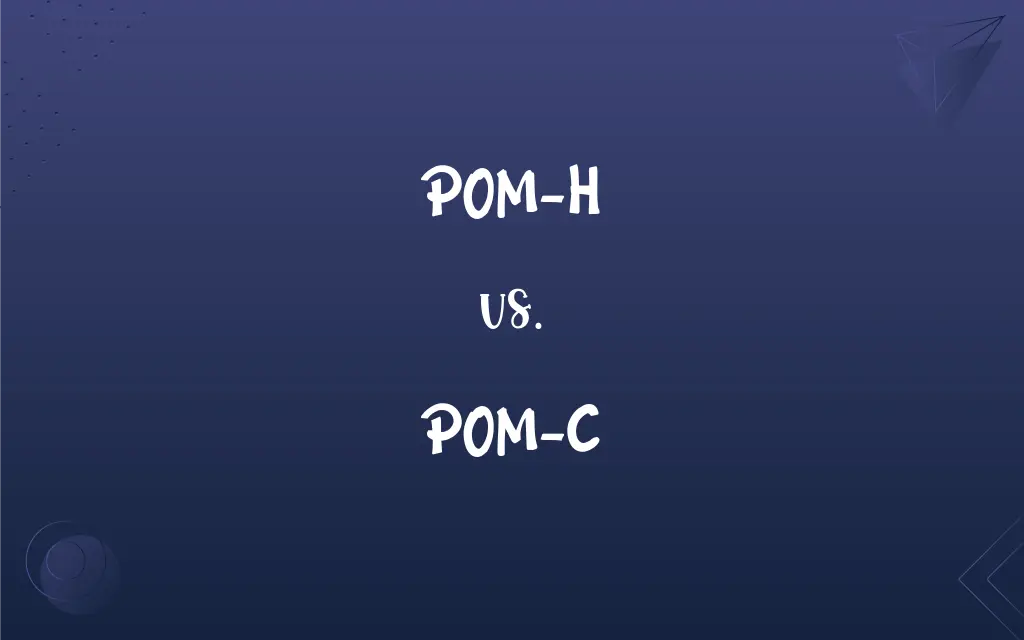POM-H vs. POM-C: What's the Difference?
Edited by Janet White || By Harlon Moss || Published on February 24, 2024
POM-H is homopolymer form of Polyoxymethylene. POM-C is copolymer form of Polyoxymethylene.

Key Differences
POM-H, or Polyoxymethylene Homopolymer, consists of repeating units derived from a single monomer, offering high strength and rigidity. POM-C, the Polyoxymethylene Copolymer, is made from two different monomers, resulting in slightly lower strength but better thermal stability.
The homopolymer POM-H generally has a higher melting point and is more crystalline than POM-C. In contrast, POM-C copolymer has a lower melting point, making it more suitable for applications requiring higher thermal resistance.
POM-H is more susceptible to acid hydrolysis and is less stable in alkaline conditions compared to POM-C. POM-C offers better chemical resistance, particularly in alkaline environments.
POM-H is preferred for applications requiring high mechanical strength and rigidity, such as gears and bearings. POM-C is more suitable for parts requiring stability in varying chemical and thermal conditions.
In terms of machining, POM-H can be more challenging due to its rigidity, requiring sharp tools and precise control. POM-C, with its slightly lower hardness, can be easier to machine, allowing for more versatility in manufacturing processes.
ADVERTISEMENT
Comparison Chart
Composition
Made from a single type of monomer
Made from two different monomers
Melting Point
Higher melting point
Lower melting point
Chemical Resistance
Less resistant to acid hydrolysis
Better chemical resistance, especially in alkaline environments
Preferred Applications
High-strength mechanical parts
Parts requiring thermal and chemical stability
Machinability
More challenging due to rigidity
Easier to machine due to lower hardness
ADVERTISEMENT
POM-H and POM-C Definitions
POM-H
POM-H has a higher melting point than POM-C, making it less ideal for high-temperature applications.
POM-H is not recommended for parts exposed to high temperatures.
POM-C
POM-C is easier to machine than POM-H due to its lower hardness.
Machining intricate parts is easier with POM-C.
POM-H
POM-H offers excellent dimensional stability and low moisture absorption.
We use POM-H for components that require precise tolerances.
POM-C
POM-C is a copolymer version of Polyoxymethylene, offering better thermal stability than POM-H.
POM-C is used in applications where thermal resistance is crucial.
POM-H
POM-H is suitable for applications with high mechanical load.
The conveyor rollers are fabricated from POM-H due to its load-bearing capacity.
POM-C
POM-C has a lower melting point, making it more suitable for certain manufacturing processes.
We use POM-C for components that require complex thermal processing.
POM-H
POM-H can be more susceptible to acid hydrolysis compared to POM-C.
For acidic environments, POM-H might not be the best choice.
POM-C
POM-C is often used for parts that encounter varying chemical and thermal environments.
In our chemical processing unit, POM-C is the preferred material.
POM-H
POM-H is a homopolymer form of Polyoxymethylene, characterized by high strength and stiffness.
The gears are made of POM-H for their high durability.
POM-C
POM-C exhibits improved chemical resistance, especially in alkaline conditions.
For chemical exposure, we prefer POM-C for its resistance.
FAQs
Can POM-H resist acid hydrolysis?
POM-H is more susceptible to acid hydrolysis than POM-C.
What are common applications of POM-H?
Used in high-strength mechanical parts like gears and bearings.
What is POM-H?
It's the homopolymer form of Polyoxymethylene.
Can POM-C handle high mechanical loads?
Yes, but POM-H is typically better for very high-load applications.
Is POM-C resistant to alkaline conditions?
Yes, POM-C offers better resistance in alkaline environments.
How do POM-H and POM-C differ in strength?
POM-H is generally stronger and stiffer than POM-C.
What is POM-C?
It's the copolymer form of Polyoxymethylene.
Which has better thermal stability, POM-H or POM-C?
POM-C has better thermal stability.
What is the melting point comparison between POM-H and POM-C?
POM-H has a higher melting point than POM-C.
Does the machining of POM-H require special tools?
It requires sharp tools and precise control due to its rigidity.
Where is POM-C typically used?
In parts requiring stability in chemical and thermal conditions.
Which is easier to machine, POM-H or POM-C?
POM-C is generally easier to machine.
How do POM-H and POM-C react to chemical exposure?
POM-H is less resistant to chemicals, especially acids, compared to POM-C.
Is POM-H recyclable?
Yes, like POM-C, it can be recycled.
Are there any special handling requirements for POM-C?
Standard handling for plastics applies, but no special requirements beyond those.
What should I consider when choosing between POM-H and POM-C?
Consider factors like mechanical strength, thermal and chemical resistance, and machinability.
How does moisture absorption compare between POM-H and POM-C?
POM-H has lower moisture absorption.
Can POM-C be used in acidic environments?
POM-C is more resistant than POM-H but still has limitations in acidic conditions.
Is POM-H suitable for high-temperature applications?
It is less ideal due to its higher melting point.
Are POM-H and POM-C resistant to wear and tear?
Yes, both materials have good wear resistance.
About Author
Written by
Harlon MossHarlon is a seasoned quality moderator and accomplished content writer for Difference Wiki. An alumnus of the prestigious University of California, he earned his degree in Computer Science. Leveraging his academic background, Harlon brings a meticulous and informed perspective to his work, ensuring content accuracy and excellence.
Edited by
Janet WhiteJanet White has been an esteemed writer and blogger for Difference Wiki. Holding a Master's degree in Science and Medical Journalism from the prestigious Boston University, she has consistently demonstrated her expertise and passion for her field. When she's not immersed in her work, Janet relishes her time exercising, delving into a good book, and cherishing moments with friends and family.







































































